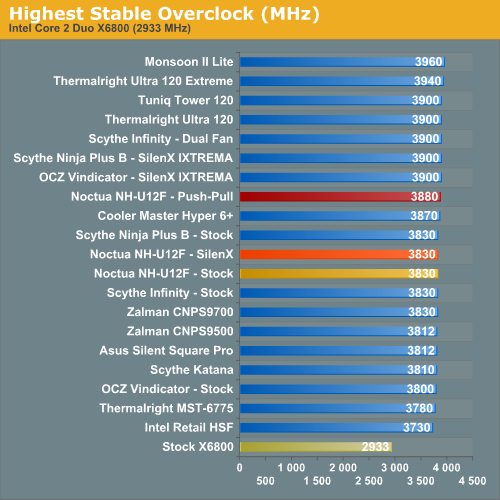Noctua NH-U12F: Quiet Air Cooling from Austria
by Wesley Fink on April 25, 2007 4:00 AM EST- Posted in
- Cases/Cooling/PSUs
Overclocking
As cooling solutions do a better job of keeping the CPU at a lower temperature, it is reasonable to expect the overclocking capabilities of the CPU will increase. In each test of a cooler we measure the highest stable overclock of a standard X6800 processor under the following conditions:CPU Multiplier: 14x (Stock 11x)
CPU voltage: 1.5875V
FSB Voltage: 1.30V
Memory Voltage: 1.90V
nForce SPP Voltage: 1.35V
nForce MCP Voltage: 1.7V
HT nForce SPP <-> MCP:
Auto
Memory is set to Auto timings on the 680i and memory speed is linked to the FSB for the overclocking tests. This removes memory as any kind of impediment to the maximum stable overclock. Linked settings on the 680i are a 1066FSB to a memory speed of DDR2-800. As FSB is raised the linked memory speed increases in proportion. The same processor is used in all cooling tests to ensure comparable results.

The Noctua NH-U12F with the stock low-noise fan reached 3.83GHz in the overclocking test. This was below the top coolers evaluated so far, which generally reached 3.90GHz with the same CPU and configuration. The SilenX high-output, low-noise fan did not improve these results, which was something of a surprise. However, using two Noctua NF-S12 fans in a push-pull configuration allowed the overclock to reach 3.88GHz, just below the typical OC for the best coolers we have tested.
The 3.88GHz is so close to 3.90GHz as to be an insignificant difference in performance. However, if you refer back to stress temperatures at 3.88GHz, you will clearly see that the Noctua with push-pull fans is not cooling nearly as well as the very best coolers, like the two top Thermalrights and the Tuniq Tower 120. This is still excellent performance in overclocking for a cooler that was clearly designed for quiet first, but we hoped for a bit better performance at the top given the similarities in appearance between the Noctua and the Thermalrights.
The best air cooler tested topped out at 3.94GHz. The rest of the best air coolers reached 3.90GHz. 3.88GHz is excellent performance, but no challenge for the best tested so far.










30 Comments
View All Comments
tk11 - Wednesday, April 25, 2007 - link
Enough with the heat sink reviews. They make something hot, cool... big deal... they're all virtually identical. Please review an interesting or useful technology before we all loose interest in the site.poohbear - Wednesday, April 25, 2007 - link
lol they're all virtually identical eh? u obviously do NOT overclock.tk11 - Wednesday, April 25, 2007 - link
Actually I do overclock... by identical I was referring to the lack of innovation. The main differences between these coolers are size and styling, neither of which require technical analysis. Being a long time reader I was simply expressing my lack of interest in the latest series of reviews in hopes that anandtech will return to covering some of the more interesting technologies.LoneWolf15 - Wednesday, April 25, 2007 - link
Speak for thyself, not others. Plenty of people read these; if you don't, feel free to move on.Jesse3G - Wednesday, April 25, 2007 - link
I'm amused that you freely speak for others, but presume to restrict the privlege from another? Your post flirts with hypocrisy and the person you addressed brought up a valid opinion.Personally I'm surprised at the management decision on this cooling coverage. Why handle one at a time when this topic can clearly be consolidated into a comprehensive discussion of cooling??? A true "round-up" would compile all of these reviews into an inclusive article for each major cooling system category, with Anantech's enclosed suggestions of the best setups available.
SurJector - Wednesday, April 25, 2007 - link
That would be nice to have those noise ratings: how does the stock fan compares with the SilenX and how much more noise the push-pull configuration makes ?Thanks for the reviews.
Wesley Fink - Wednesday, April 25, 2007 - link
We did try SilenX with push pull and the noise ratings were still below the system noise floor set by the power supply. Cooling performance was roughly the same as the stock Noctua fans in push-pull and the overclock was not extended, so we saw no reason to pursue it further. The Noctua ultra low noise fan appears to push a lot of air and apparently generates high air pressure compared to some other low noise solutions.puffpio - Wednesday, April 25, 2007 - link
So then..the ultimate review would probably be these Noctua 120mm fans on an Thermalright Ultra 120 Extreme in a push pull?poohbear - Wednesday, April 25, 2007 - link
well can u guys bug thermalright for an advance review of their IFX-14? u guys managed to review the TR ultra 120+ early, maybe u can do the same w/ the monstrous IFX-14?Wesley Fink - Friday, April 27, 2007 - link
Thermalright has just advised us that the Thermalright Ultra-120 eXtreme is in full production. The problem with the mounting plate has been corrected in the release cooler."The 775 bracket issue has been addressed and Ultra-120 eXtreme is now in full production. We think it’s even better than the engineering piece you received back then. Would you be able to verify that if we were to send you the “production” sample with its own packaging and all? I think you’ll be pleased to see the results and the improvements."
We have a final production sample with improvements on the way. We also have requested an IFX-14 for review.